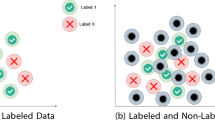Decision trees have been applied to problems such as assigning protein function and predicting splice sites. How do these classifiers work, what types of problems can they solve and what are their advantages over alternatives?

Similar content being viewed by others
References
Quinlan, J.R. C4.5: Programs for Machine Learning. (Morgan Kaufmann Publishers, San Mateo, CA, USA, 1993).
Breiman, L., Friedman, J., Olshen, R. & Stone, C. Classification and Regression Trees (Wadsworth International Group, Belmont, CA, USA, 1984).
Caruana, R. & Niculescu-Mizil, A. An empirical comparison of supervised learning algorithms. in Machine Learning, Proceedings of the Twenty-Third International Conference (eds. Cohen, W.W. & Moore, A.) 161–168 (ACM, New York, 2003).
Zadrozny, B. & Elkan, C. Obtaining calibrated probability estimates from decision trees and naive Bayesian classifiers. in Proceedings of the 18th International Conference on Machine Learning, (eds. Brodley, C.E. & Danyluk, A.P.) 609–616 (Morgan Kaufmann, San Francisco, 2001).
Murthy, S.K., Kasif, S. & Salzberg, S. A system for induction of oblique decision trees. J. Artif. Intell. Res. 2, 1–32 (1994).
MacKay, D.J.C. Information Theory, Inference and Learning Algorithms (Cambridge University Press, Cambridge, UK, 2003).
Quinlan, J.R. & Rivest, R.L. Inferring decision trees using the Minimum Description Length Principle. Inf. Comput. 80, 227–248 (1989).
Breiman, L. Random forests. Mach. Learn. 45, 5–32 (2001).
Heath, D., Kasif, S. & Salzberg, S. Committees of decision trees. in Cognitive Technology: In Search of a Human Interface (eds. Gorayska, B. & Mey, J.) 305–317 (Elsevier Science, Amsterdam, The Netherlands, 1996).
Schapire, R.E. The boosting approach to machine learning: an overview. in Nonlinear Estimation and Classification (eds. Denison, D.D., Hansen, M.H., Holmes, C.C., Mallick, B. & Yu, B.) 141–171 (Springer, New York, 2003).
Freund, Y. & Mason, L. The alternating decision tree learning algorithm. in Proceedings of the 16th International Conference on Machine Learning, (eds. Bratko, I. & Džeroski, S.) 124–133 (Morgan Kaufmann, San Francisco, 1999).
Wong, S.L. et al. Combining biological networks to predict genetic interactions. Proc. Natl. Acad. Sci. USA 101, 15682–15687 (2004).
Allen, J.E., Majoros, W.H., Pertea, M. & Salzberg, S.L. JIGSAW, GeneZilla, and GlimmerHMM: puzzling out the features of human genes in the ENCODE regions. Genome Biol. 7 Suppl, S9 (2006).
Middendorf, M., Kundaje, A., Wiggins, C., Freund, Y. & Leslie, C. Predicting genetic regulatory response using classification. Bioinformatics 20, i232–i240 (2004).
Chen, X.-W. & Liu, M. Prediction of protein-protein interactions using random decision forest framework. Bioinformatics 21, 4394–4400 (2005).
Author information
Authors and Affiliations
Rights and permissions
About this article
Cite this article
Kingsford, C., Salzberg, S. What are decision trees?. Nat Biotechnol 26, 1011–1013 (2008). https://doi.org/10.1038/nbt0908-1011
Issue Date:
DOI: https://doi.org/10.1038/nbt0908-1011
- Springer Nature America, Inc.
This article is cited by
-
Machine-learning analysis reveals an important role for negative selection in shaping cancer aneuploidy landscapes
Genome Biology (2024)
-
Artificial intelligence-based methods for renewable power system operation
Nature Reviews Electrical Engineering (2024)
-
Machine learning assisted adsorption performance evaluation of biochar on heavy metal
Frontiers of Environmental Science & Engineering (2024)
-
Artificial intelligence assisted tools for the detection of anxiety and depression leading to suicidal ideation in adolescents: a review
Cognitive Neurodynamics (2024)
-
Machine learning prediction of mortality in Acute Myocardial Infarction
BMC Medical Informatics and Decision Making (2023)





